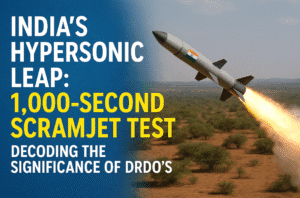India’s Hypersonic Leap: Decoding the Significance of DRDO’s 1,000-Second Scramjet Test
India’s DRDO has achieved a critical milestone in hypersonic technology by successfully testing an active-cooled scramjet combustor for 1,000 seconds—a leap from its 120-second trial earlier this year. This endurance test validates advanced cooling systems and combustion stability at Mach 5+ speeds, addressing extreme heat challenges that have hindered global scramjet development. Unlike traditional rockets, scramjets use atmospheric oxygen, enabling lighter, faster, and longer-range hypersonic cruise missiles capable of evading modern defenses.
The breakthrough strengthens India’s strategic deterrence, reduces reliance on foreign tech, and positions it alongside the U.S., Russia, and China in the hypersonic race. While scaling to full-flight systems and heat-resistant materials remain hurdles, the test signals progress toward operational weapons within a decade. Beyond defense, this achievement underscores India’s ambition to lead in cutting-edge aerospace innovation, balancing regional security dynamics and advancing its vision of self-reliance.
The milestone isn’t just technical—it’s a strategic statement in an era where speed defines military dominance.

India’s Hypersonic Leap: Decoding the Significance of DRDO’s 1,000-Second Scramjet Test
India’s pursuit of hypersonic technology reached a critical milestone as the Defence Research and Development Organisation (DRDO) announced the successful 1,000-second ground test of an active-cooled scramjet subscale combustor. Conducted at DRDO’s Hyderabad-based laboratory, this achievement marks a quantum leap from the 120-second test reported earlier in 2024. Beyond the technical jargon, here’s why this breakthrough matters—for India’s defense capabilities and the global hypersonic race.
Why 1,000 Seconds? The Science Behind the Scramjet
Scramjets (supersonic combustion ramjets) are air-breathing engines designed to operate at hypersonic speeds (Mach 5+). Unlike traditional rocket engines, which carry onboard oxidizers, scramjets “breathe” atmospheric oxygen, making them lighter and ideal for sustained hypersonic flight. However, sustaining combustion at such speeds creates extreme temperatures (over 2,500°C), necessitating advanced cooling systems to prevent engine meltdown.
The DRDO’s 1,000-second test validates two breakthroughs:
- Active Cooling Technology: By circulating coolant through the combustor walls, the engine can endure prolonged hypersonic conditions—critical for practical applications like missiles or reusable drones.
- Combustion Stability: Maintaining supersonic airflow while injecting and igniting fuel for over 16 minutes demonstrates precision engineering, a hurdle even advanced nations grapple with.
For perspective, the U.S. X-51 Waverider’s scramjet, a benchmark in hypersonics, managed 210 seconds of flight in 2013. While ground tests differ from real-world conditions, India’s progress signals a robust foundation for future flight trials.
Strategic Implications: A Game-Changer for National Security
Hypersonic weapons are reshaping modern warfare. Their blistering speed, maneuverability, and low-altitude flight paths render traditional missile defense systems obsolete. By advancing scramjet technology, India positions itself among a select group of nations (U.S., Russia, China) capable of deploying such systems.
Key strategic takeaways:
- Deterrence Boost: Hypersonic cruise missiles could strike high-value targets (e.g., aircraft carriers, underground bunkers) with minimal warning time, enhancing India’s conventional and nuclear deterrence.
- Atmanirbhar Bharat in Defense: The test underscores India’s shift from reliance on imports to indigenous R&D. Collaboration between DRDO, private industries, and academia—as highlighted by Defence Minister Rajnath Singh—accelerates this vision.
- Regional Balance: In a region marked by China’s hypersonic advancements (DF-ZF glide vehicle) and Pakistan’s evolving missile arsenal, India’s progress recalibrates the power dynamics.
The Road Ahead: From Lab to Battlefield
While the 1,000-second test is a triumph, challenges remain:
- Scaling Up: Subscale combustor success must translate to full-scale, flight-worthy engines.
- Material Science: Developing heat-resistant alloys and coatings for sustained hypersonic flight.
- Integration: Pairing scramjets with hypersonic glide vehicles (HGVs) for a complete weapon system.
DRDO’s next goal—a full-scale hypersonic cruise missile—could materialize within this decade, building on programs like the Hypersonic Technology Demonstrator Vehicle (HSTDV), tested in 2020.
A Global Context: India’s Hypersonic Ascent
Globally, hypersonic technology is a dual-use frontier, with civilian applications (space launch systems, rapid global transport) alongside military uses. India’s strides align with its ambitions to become a defense exporter and a leader in cutting-edge tech. However, the race also demands ethical considerations, as hypersonic weapons could destabilize arms control frameworks.
Conclusion: More Than a Test
DRDO’s achievement isn’t just a technical checkbox—it’s a statement. By mastering scramjet endurance, India inches closer to a future where hypersonic systems redefine national security paradigms. As global powers jostle for supremacy, India’s blend of innovation, strategic foresight, and self-reliance could cement its role as a key player in the hypersonic age.
For now, the 1,000-second burn symbolizes a nation’s resolve to turn technological ambition into undeniable capability. The message is clear: India isn’t just keeping pace; it’s aiming to lead.
You must be logged in to post a comment.